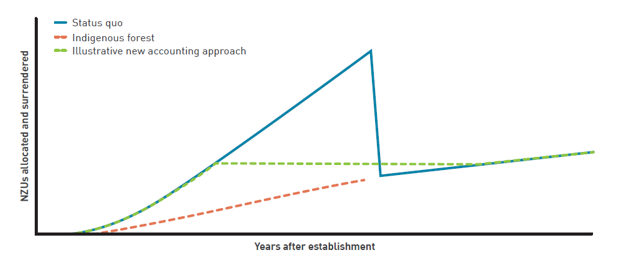Sweeping Changes Proposed for New Zealand Emissions Trading Scheme
June 2023 saw the release of two discussion documents on policy proposals that could profoundly impact New Zealand’s Emissions Trading Scheme in the medium to long term:
>A Redesigned NZ ETS Permanent Forest Category (link to consultation document)
We have endeavoured below to provide a short summary of the key aspects of each document.
Review of the New Zealand Emissions Trading Scheme
This review was prompted in part by the New Zealand Climate Change Commission’s draft advice to government, in which it raised the following concerns:
>The ETS-led planting boom would lead to a surplus of carbon credits and permanently commit large swathes of land to forestry. This was to the detriment of future generations and, potentially, New Zealand’s climate targets if these forests were destroyed by fire and disease.
In response, the government has put the following options up for discussion:
Option 1: Use existing levers to strengthen incentives for net emissions reductions
The government would encourage higher NZU prices by changing the settings used for the quarterly NZU auctions (e.g. raise cost containment reserve), and/or by reducing the free industrial allocations.
The government would allow offshore buyers to purchase forestry NZUs and potentially become a buyer of forestry NZUs itself. The secondary market would continue to operate as before.
This option would create two prices: one for emissions reduction activities and another for removal activities (forestry). A lower price will apply to removal activities, making them less financially attractive.
This option would effectively see the ETS split in two by decoupling the price of NZUs paid by emitters from the price received by forest owners. The intention is for emitters to pay more for NZUs and for forest owners to receive less. The secondary market for forestry NZUs would likely be severly curtailed as a major buyer group (local emitters) would be excluded from it.
While the government concedes that Option 4 will be the most challenging – and take the longest – to implement, it stood out from the other options in that the “Expected Impacts” section listed few, if any, potential adverse effects, focussing mainly on the potential benefits.
What happens next?
The consultation document makes clear that any changes resulting from the review and consultation process will be implemented after this year’s election and at the discretion of the next government.
The proposed options will impact all ETS participants in different ways, so we think it is important for our clients to make their own submissions on what is important to them: Link to online “quick submission” form with four questions. Submissions close at 11.59 pm on 11 August 2023.
Redesign of NZ ETS Permanent Forest Category
Following a first round of consultations in 2022, the government is proposing to impose significant restrictions on the Permanent Forest category, which was launched at the start of the year and is effectively the successor version of the Permanent Forest Sink Initiative (PFSI). The restrictions would be implemented some time after the next election and at the discretion of the next government.
The proposed restrictions are in response to concerns voiced by some stakeholder groups about the impacts of large-scale permanent exotic carbon forests on the environment and rural communities.
Two options are being considered:
Option 1.1
Only transition forests and indigenous forests can enter the permanent forest category
“Transition forests” are forests that are established with fast-growing exotic tree species, such as radiata, and then gradually transitioned to forests comprised predominantly of native tree species.
The government is also consulting on a new carbon accounting system designed to avoid the significant surrender liability that transition forests would be subject to at the transition point under stock change accounting, as illustrated below.
Option 1.2
Exotic forests allowed to enter under limited circumstances – for example, only certain types/ locations/ ownership characteristics of the exotic forest allowed. The following sub-options are not mutually exclusive:
a. Long-lived exotic species, such as redwoods
b. Māori-owned land
c. Exotic forests planted on small-scale (e.g. up to 50 ha in size) forests on farms.
Notably, the option of maintaining the status quo (exotic tree species are permitted in the Permanent Forest category without restrictions) is not being consulted on.
What happens next?
The consultation documents makes clear that any changes resulting from the review and consultation process will be implemented after this year’s election and at the discretion of the next government.
The proposed options will impact all ETS participants in different ways, so we think it is important for our clients to make their own submissions on what is important to them: Link to online submission form. Submissions close at 11.59 pm on 11 August 2023.

